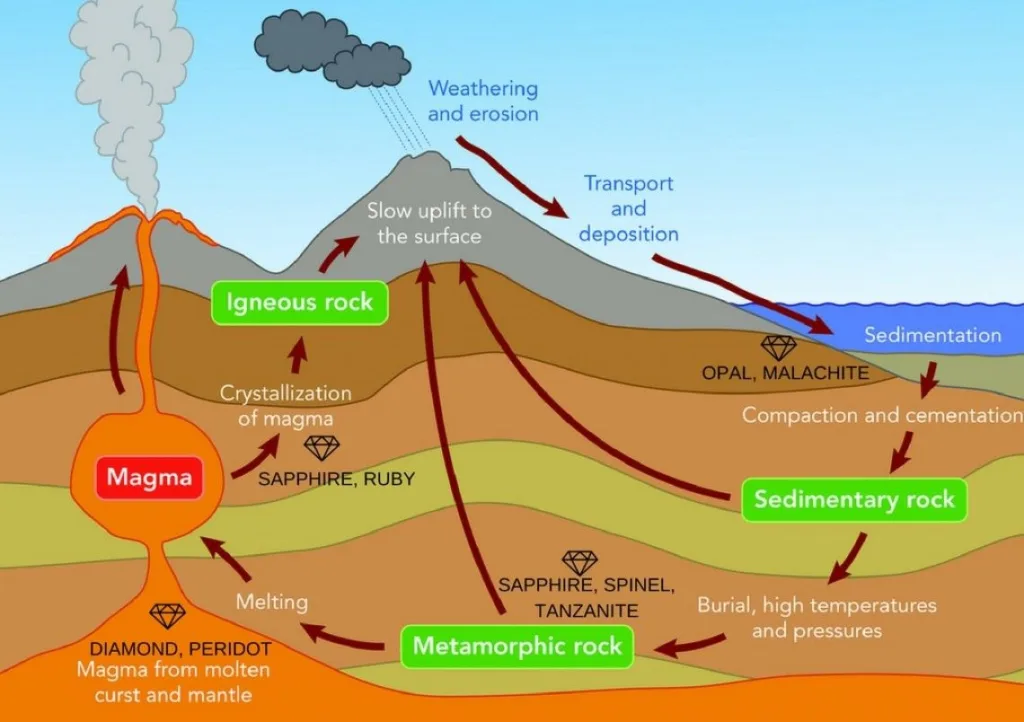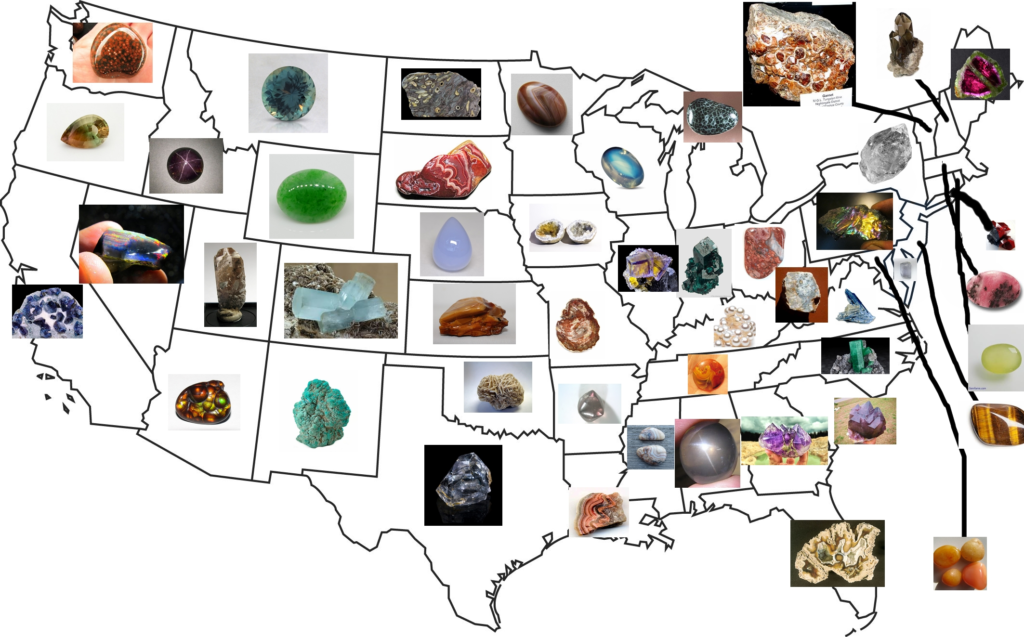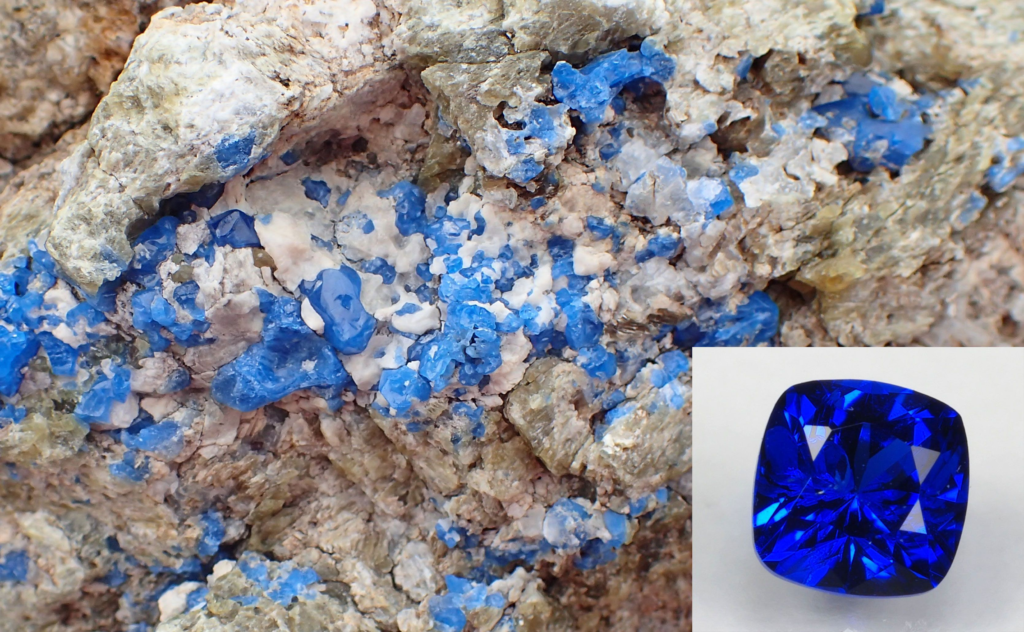Volcanoes are not only powerful natural phenomena but also crucial contributors to the Earth’s geology, particularly in the formation of gemstones. The intense heat and pressure associated with volcanic activity create the perfect conditions for the formation of these precious stones. As magma rises towards the Earth’s surface, it cools and crystallizes, sometimes trapping minerals that eventually form gemstones. Additionally, the violent eruptions can bring deeper earth materials to the surface, where they cool quickly, forming crystalline structures.

Studying the creation of gemstones through volcanic activity is significant for both geological and commercial reasons. Geologically, it helps scientists understand the processes that shape the Earth’s crust and contribute to its mineral wealth. Commercially, understanding these processes can aid in the exploration and mining of gemstones, making it a crucial area of research for the gemstone industry. This dual importance drives ongoing scientific research and exploration in volcanic regions around the world.
Volcanic Processes and Gemstone Formation

Volcanic activity is characterized by the movement and eruption of magma from deep within the Earth. When this magma reaches the surface, it becomes lava. This process not only shapes the physical landscape but also influences the formation of gemstones through the interactions of heat, pressure, and mineral-rich fluids.
Heat and Pressure in Volcanoes
The intense heat and high pressure within volcanic environments are critical to gemstone formation. As magma ascends through the Earth’s crust, it undergoes changes in temperature and pressure, promoting the growth of crystals from mineral-rich solutions. These conditions allow atoms to arrange into precise, orderly patterns that are essential for the development of crystalline structures typical of gemstones.
Types of Gemstones Formed in Volcanic Settings
- Diamonds: Perhaps the most famous volcanic gemstones, diamonds form under extreme pressure and heat at great depths. They are often brought to the surface by explosive volcanic eruptions known as kimberlite pipes, which act as elevators for these deep-seated gems.
- Opals: These are formed from silica-rich waters that percolate through volcanic rocks, depositing layers of silica spheres in cracks and cavities. The unique play of color in opals comes from the diffraction of light by these microscopic spheres.
- Peridot: Often found in volcanic basalt rocks, peridot crystallizes from magma that is rich in iron and magnesium. It is one of the few gemstones that exist in only one color, a distinctive shade of green, which is a result of its iron content.
Understanding these processes and the types of gemstones associated with volcanic activity helps geologists locate potential mining areas and provides insights into the dynamic processes occurring beneath the Earth’s surface.
Famous Volcanic Gemstone Localities
Certain regions around the world are renowned for their rich deposits of volcanic gemstones, which have significantly influenced local economies and cultures. Here are three notable examples:
Kimberley Mines, South Africa

The Kimberley mines in South Africa are synonymous with diamonds. Discovered in the late 19th century, these mines were the site of the first major diamond rush, establishing South Africa as a primary source of large, high-quality diamonds. The economic impact was profound, leading to rapid industrial and economic growth within the region. The influx of prospectors and wealth fundamentally changed the social fabric and led to significant infrastructural developments. Today, the legacy of the Kimberley mines continues to influence South Africa’s economy and its position in the global diamond industry.
Peridot from the San Carlos Apache Indian Reservation, Arizona

The San Carlos Apache Indian Reservation in Arizona is one of the world’s largest sources of peridot. The gemstones are found in basaltic lava flows and are mined primarily by the Apache community members. The mining of peridot has provided economic opportunities to the reservation’s inhabitants, who otherwise face limited employment prospects. The cultural significance of peridot, coupled with its economic benefits, highlights its importance to the San Carlos Apache community, not just as a source of income but also as a cultural treasure.
Opal Mines in Australia

Australia is famous for its opal mines, with significant deposits found in regions such as Coober Pedy, Lightning Ridge, and Andamooka. Australian opals are celebrated for their quality and unique characteristics, particularly the vibrant play of color. The discovery of opals has transformed these areas, turning them into bustling mining towns. The opal industry has become a cornerstone of these local economies, attracting tourists and gem enthusiasts from around the world. Furthermore, opal mining has become a part of the cultural identity of these regions, with local traditions and histories deeply intertwined with the mining of this precious gemstone.
These localities exemplify how volcanic gemstone mining can shape the economic and cultural landscapes of regions, providing both challenges and opportunities for the communities involved.
Geological Conditions for Gemstone Viability

OR- sunstone
CA- benitoite
NV- black virgin opal
ID- star garnet
UT- topaz
AZ- Fire agate
NM- tourquoise
CO- aquamarine
KS- jellinite amber
WY- nephrite jade
MT- sapphire
ND- north Dakota petrified wood
SD- fairburn agate
NE- blue chalcedony
OK- barite rose
TX- texas blue topaz
MN- lake superior agate. : r/rockhounds (reddit.com)
The formation of gemstones in volcanic settings is dependent on a unique set of geological conditions. These conditions involve specific combinations of temperature, pressure, mineral content, and fluid dynamics.
Conditions in Volcanic Environments
- Temperature and Pressure: High temperatures and pressures are essential for the formation of gemstones like diamonds, which form under conditions of extreme depth and are brought to the surface by volcanic eruptions. The rapid cooling of magma also helps form crystalline structures in other gemstones like peridot.
- Mineral-Rich Fluids: The presence of mineral-rich fluids is crucial as these fluids facilitate the growth of gemstones. For example, opals form from silica-rich waters that seep into crevices in volcanic rock, solidifying into gel and eventually opal.
- Gas Phases: Certain gems, like topaz, can form from the gas phases in volcanic magmas under the right chemical conditions.
Comparison with Non-Volcanic Gemstone Formation
Volcanic Settings:
- Gemstones such as diamonds, peridot, and obsidian are typically formed in volcanic settings.
- These environments are characterized by sudden changes in pressure and temperature, which can lead to the rapid growth of crystals.
- The dynamic nature of volcanic activity often results in gemstones with unique and striking features.
Sedimentary Settings:
- In contrast, sedimentary environments typically produce gemstones such as opal, malachite, and turquoise.
- These settings involve the deposition of minerals from water, often over long periods, leading to the gradual formation of gemstones.
- The conditions are generally less extreme than volcanic settings, but the presence of water plays a critical role.
Metamorphic Settings:
- Another notable geological setting for gemstone formation is metamorphic environments where high pressure and temperature, but not necessarily magma, alter the mineralogical composition of rocks.
- Gems like sapphire and garnet are often formed in these conditions.
The differences in formation environments influence not only the types of gemstones produced but also their physical properties, such as hardness, clarity, and color. Each type of gemstone carries unique markers of its geological history, which can significantly affect its value and rarity.
Economic Impact of Volcanic Gemstones

The extraction and trade of volcanic gemstones have significant economic impacts on various scales, from local communities to global markets. Here’s how these precious resources shape economies:
Local Economic Growth
- Job Creation: Mining operations in areas with volcanic gemstones often provide critical employment opportunities in regions where alternative jobs may be scarce. This includes direct jobs in the mines and indirect roles in services and supply chains supporting mining activities.
- Infrastructure Development: Mining companies frequently invest in infrastructure improvements, such as roads and utilities, to facilitate their operations. This development can benefit local communities by providing better access to transportation and modern amenities.
- Community Investments: Some mining companies engage in corporate social responsibility activities that involve investing in local communities. This can include education, healthcare, and environmental conservation projects, which improve the quality of life for local residents.
National and Regional Economies
- Export Revenues: Volcanic gemstones such as diamonds, rubies, and opals can command high prices on the international market, providing significant export revenues for producing countries. These revenues can be a substantial part of a nation’s foreign exchange earnings.
- Market Volatility and Risk: The gemstone market can be highly volatile, with prices influenced by changes in fashion, economic conditions, and geopolitical events. This volatility can pose risks to economies that are heavily dependent on gemstone exports.
- Regulation and Policy: Government policies and regulations around mining and exports can greatly affect the economic impact of gemstone mining. Effective regulation is needed to ensure that gemstone mining is sustainable and that revenues are used to support long-term economic development.
Global Impact
- Supply Chains: The gemstone supply chain is global, involving miners, traders, cutters, polishers, jewelry manufacturers, and retailers. This creates a complex web of economic activities around the world, each adding value to the final product.
- Sustainable and Ethical Mining: There is growing consumer demand for sustainably and ethically sourced gemstones. This has led to changes in mining practices and the establishment of certification schemes to assure buyers of the ethical origins of their gemstones, which can also add to the economic value of the gems.
- Innovation and Technology: The economic importance of gemstones fosters innovation in mining technology and gemstone processing. This includes advancements in cutting and polishing that enhance the value of the gemstones, as well as improved mining techniques that increase efficiency and reduce environmental impact.
Overall, volcanic gemstones play a crucial role in the economies of producing countries and the global market, influencing everything from local employment to international trade policies. Their impact underscores the importance of sustainable and responsible mining practices to ensure that the benefits of gemstone mining are widely distributed and long-lasting.




































